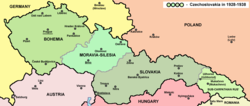Subcarpathian Autonomous Region
| Carpathian Ruthenia Podkarpatská Rus |
||||||
| Region of Czechoslovakia | ||||||
|
||||||
|
||||||
| Subcarpathian Rus within Czechoslovakia (1928) | ||||||
| Capital |
Užhorod (1919–1938) Chust (1938–1939) |
|||||
| Historical era | Interwar period | |||||
| • | Paris Peace Conference | 1919 | ||||
| • | First Vienna Award | 2 November 1938 | ||||
| • | Independence as Carpatho-Ukraine | 14 March 1939 | ||||
| • | Hungarian annexation | 15 March 1939 | ||||
| • | Integration into the Soviet Union | 29 June 1945 | ||||
| Area | ||||||
| • | 1921 | 12,097 km2(4,671 sq mi) | ||||
| Population | ||||||
| • | 1921 | 592,044 | ||||
| Density | 48.9 /km2 (126.8 /sq mi) | |||||
| Today part of |
|
|||||
Carpathian Ruthenia, Carpatho-Ukraine, or Zakarpattia (Rusyn and Ukrainian: Карпатська Русь, translit. Karpats'ka Rus', or Rusyn and Ukrainian: Закарпаття, translit. Zakarpattja; Slovak and Czech: Podkarpatská Rus; Hungarian: Kárpátalja; Romanian: Transcarpatia; Polish: Zakarpacie; German: Karpatenukraine) is a historic region in the border between Central and Eastern Europe, mostly located in western Ukraine's Zakarpattia Oblast, with smaller parts in easternmost Slovakia (largely in Prešov Region and Košice Region) and Poland's Lemkovyna. Before World War I most of this region was part of the Habsburg Kingdom of Hungary. In the interwar period, it was part of the First and Second Czechoslovak Republic. During World War II, the region was annexed by the Kingdom of Hungary once again. After the war, it became part of Soviet Ukraine.
...
Wikipedia



